QLG Case Study: SWOT, Change Management, and Stakeholders
VerifiedAdded on 2020/02/24
|14
|3841
|33
Case Study
AI Summary
This case study analyzes Queensland Leisure Goods (QLG), a business facing challenges and opportunities for growth. The assignment begins with a SWOT analysis, evaluating the company's strengths, weaknesses, opportunities, and threats. It then explores potential changes, including altering the consumer demographic and market share. The study examines the role of managers in implementing these changes, emphasizing prioritization and convincing strategies. The analysis proceeds to test these ideas through price variations and market expansion. Risk assessments and cost-benefit analyses are conducted for both demographic changes and production technology improvements. The assignment identifies key business stakeholders and proposes a change management project plan focusing on consumer demographic shifts. This plan includes resource allocation, budget estimations, a change methodology (ADKAR), implementation steps, and approval/reporting protocols. Finally, the case study outlines strategies for communicating the proposed changes, such as training conferences and stakeholder meetings.
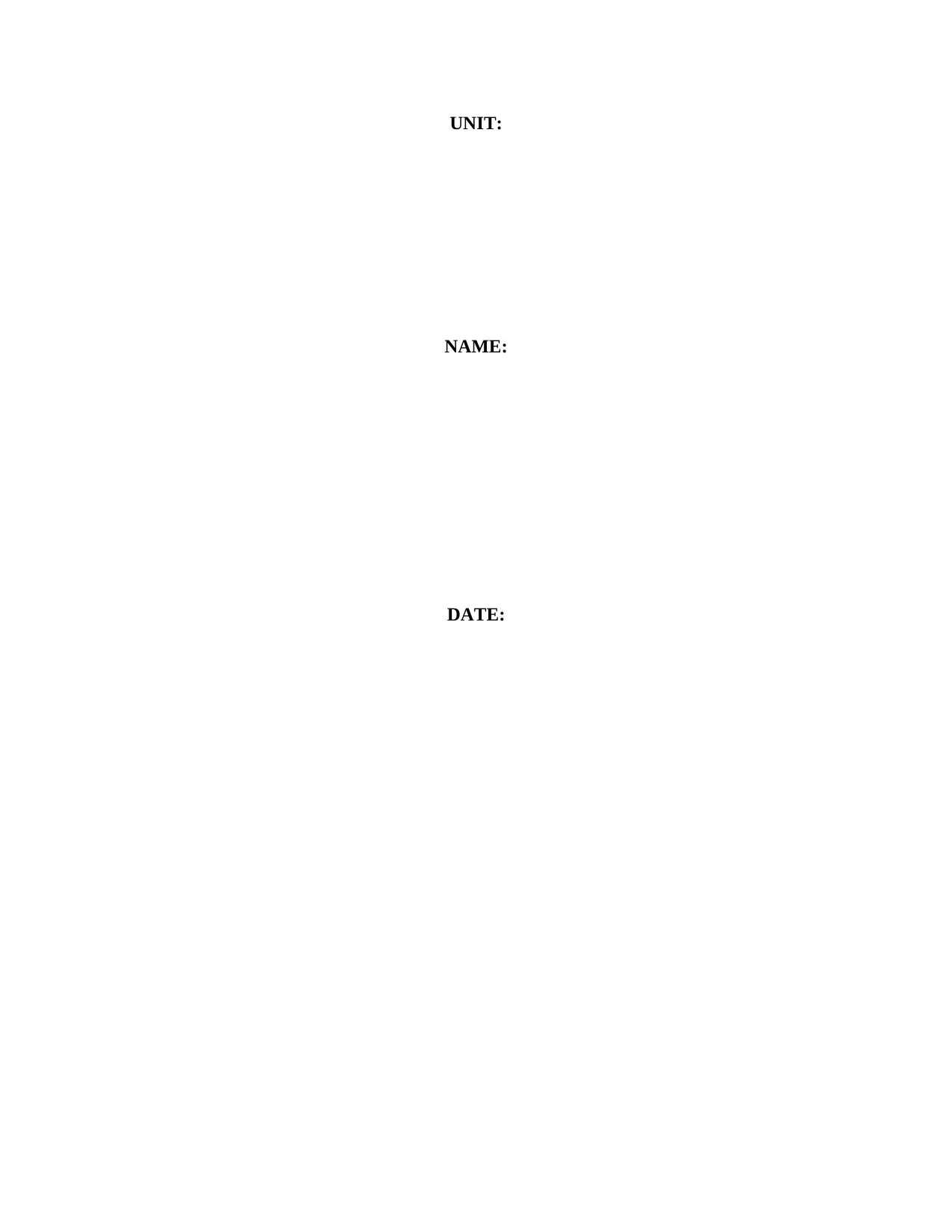
UNIT:
NAME:
DATE:
NAME:
DATE:
Paraphrase This Document
Need a fresh take? Get an instant paraphrase of this document with our AI Paraphraser
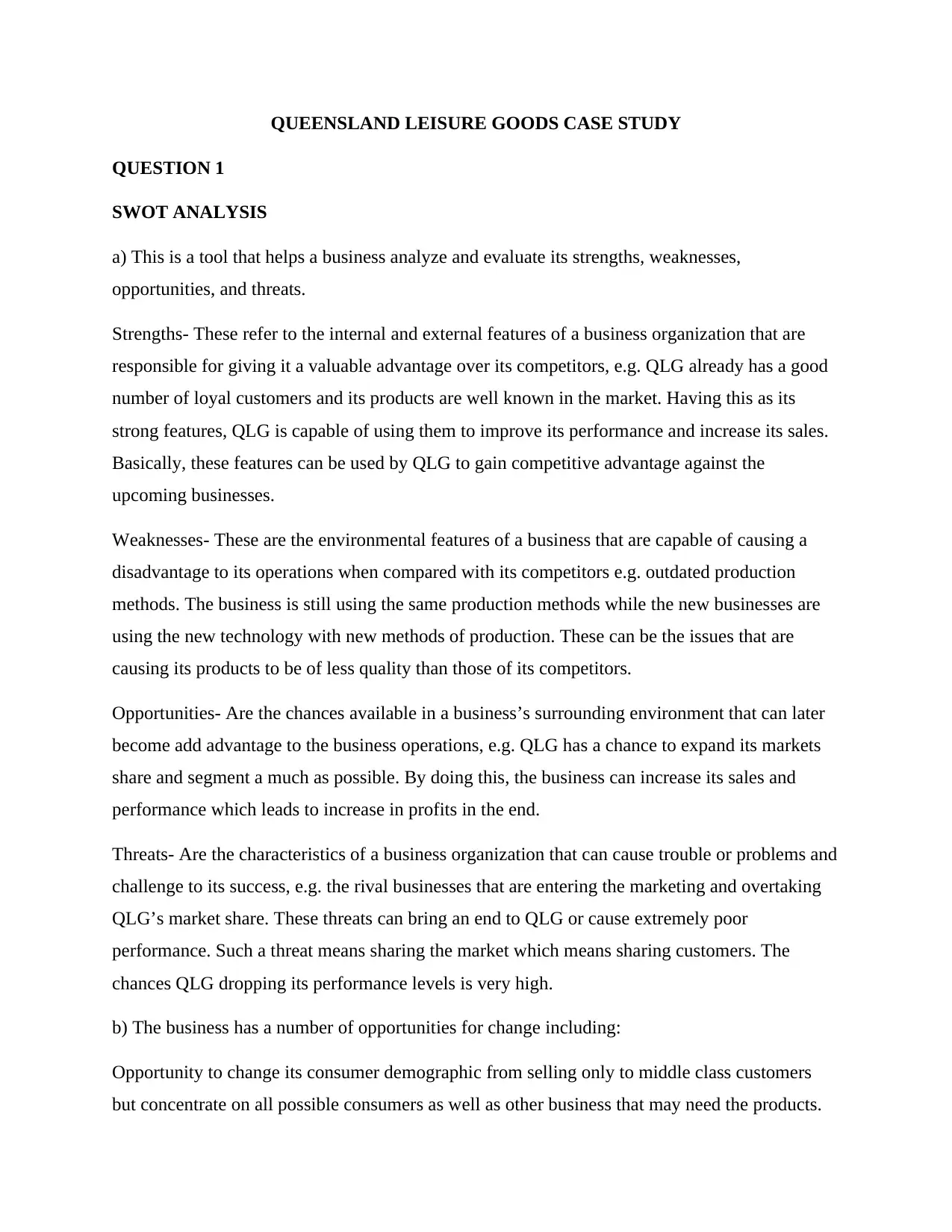
QUEENSLAND LEISURE GOODS CASE STUDY
QUESTION 1
SWOT ANALYSIS
a) This is a tool that helps a business analyze and evaluate its strengths, weaknesses,
opportunities, and threats.
Strengths- These refer to the internal and external features of a business organization that are
responsible for giving it a valuable advantage over its competitors, e.g. QLG already has a good
number of loyal customers and its products are well known in the market. Having this as its
strong features, QLG is capable of using them to improve its performance and increase its sales.
Basically, these features can be used by QLG to gain competitive advantage against the
upcoming businesses.
Weaknesses- These are the environmental features of a business that are capable of causing a
disadvantage to its operations when compared with its competitors e.g. outdated production
methods. The business is still using the same production methods while the new businesses are
using the new technology with new methods of production. These can be the issues that are
causing its products to be of less quality than those of its competitors.
Opportunities- Are the chances available in a business’s surrounding environment that can later
become add advantage to the business operations, e.g. QLG has a chance to expand its markets
share and segment a much as possible. By doing this, the business can increase its sales and
performance which leads to increase in profits in the end.
Threats- Are the characteristics of a business organization that can cause trouble or problems and
challenge to its success, e.g. the rival businesses that are entering the marketing and overtaking
QLG’s market share. These threats can bring an end to QLG or cause extremely poor
performance. Such a threat means sharing the market which means sharing customers. The
chances QLG dropping its performance levels is very high.
b) The business has a number of opportunities for change including:
Opportunity to change its consumer demographic from selling only to middle class customers
but concentrate on all possible consumers as well as other business that may need the products.
QUESTION 1
SWOT ANALYSIS
a) This is a tool that helps a business analyze and evaluate its strengths, weaknesses,
opportunities, and threats.
Strengths- These refer to the internal and external features of a business organization that are
responsible for giving it a valuable advantage over its competitors, e.g. QLG already has a good
number of loyal customers and its products are well known in the market. Having this as its
strong features, QLG is capable of using them to improve its performance and increase its sales.
Basically, these features can be used by QLG to gain competitive advantage against the
upcoming businesses.
Weaknesses- These are the environmental features of a business that are capable of causing a
disadvantage to its operations when compared with its competitors e.g. outdated production
methods. The business is still using the same production methods while the new businesses are
using the new technology with new methods of production. These can be the issues that are
causing its products to be of less quality than those of its competitors.
Opportunities- Are the chances available in a business’s surrounding environment that can later
become add advantage to the business operations, e.g. QLG has a chance to expand its markets
share and segment a much as possible. By doing this, the business can increase its sales and
performance which leads to increase in profits in the end.
Threats- Are the characteristics of a business organization that can cause trouble or problems and
challenge to its success, e.g. the rival businesses that are entering the marketing and overtaking
QLG’s market share. These threats can bring an end to QLG or cause extremely poor
performance. Such a threat means sharing the market which means sharing customers. The
chances QLG dropping its performance levels is very high.
b) The business has a number of opportunities for change including:
Opportunity to change its consumer demographic from selling only to middle class customers
but concentrate on all possible consumers as well as other business that may need the products.
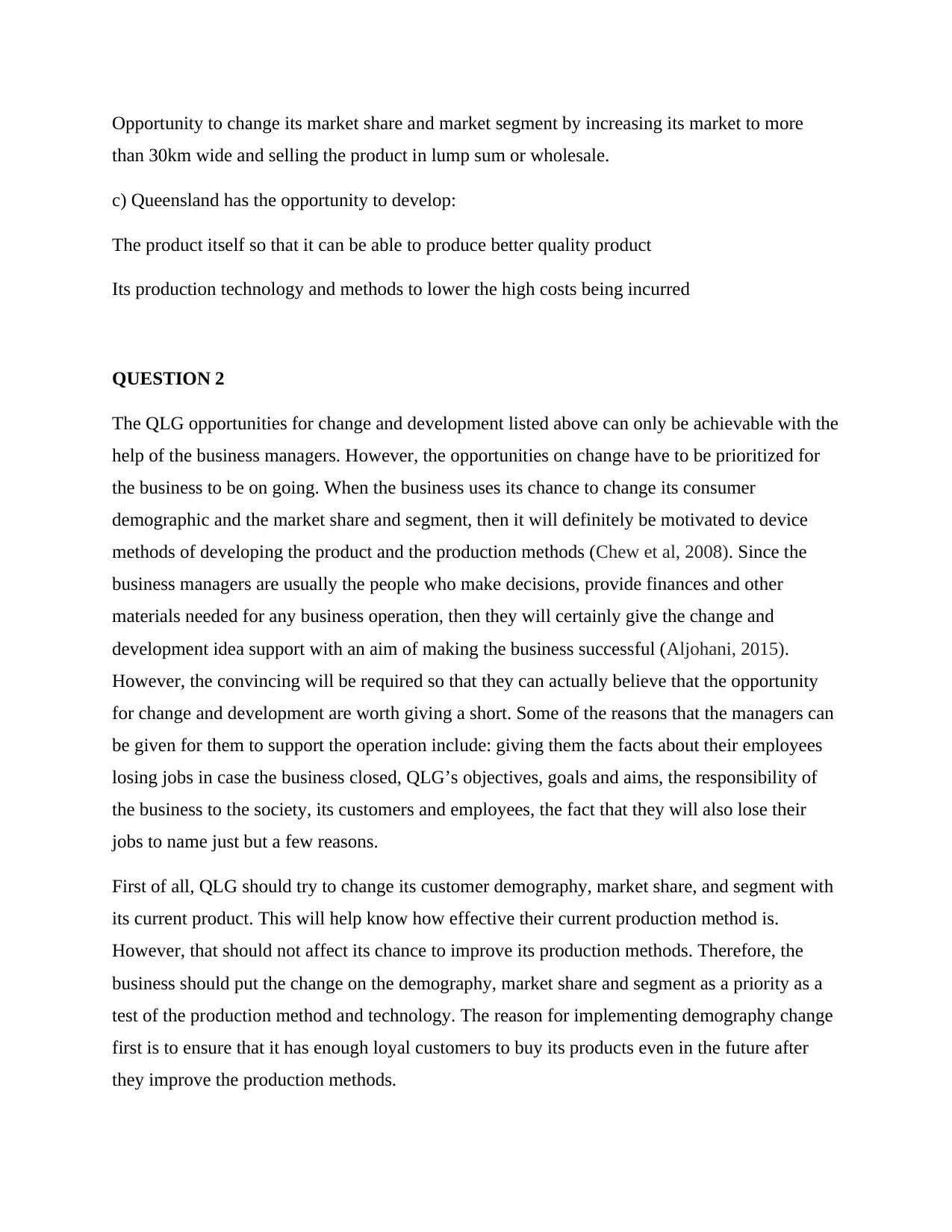
Opportunity to change its market share and market segment by increasing its market to more
than 30km wide and selling the product in lump sum or wholesale.
c) Queensland has the opportunity to develop:
The product itself so that it can be able to produce better quality product
Its production technology and methods to lower the high costs being incurred
QUESTION 2
The QLG opportunities for change and development listed above can only be achievable with the
help of the business managers. However, the opportunities on change have to be prioritized for
the business to be on going. When the business uses its chance to change its consumer
demographic and the market share and segment, then it will definitely be motivated to device
methods of developing the product and the production methods (Chew et al, 2008). Since the
business managers are usually the people who make decisions, provide finances and other
materials needed for any business operation, then they will certainly give the change and
development idea support with an aim of making the business successful (Aljohani, 2015).
However, the convincing will be required so that they can actually believe that the opportunity
for change and development are worth giving a short. Some of the reasons that the managers can
be given for them to support the operation include: giving them the facts about their employees
losing jobs in case the business closed, QLG’s objectives, goals and aims, the responsibility of
the business to the society, its customers and employees, the fact that they will also lose their
jobs to name just but a few reasons.
First of all, QLG should try to change its customer demography, market share, and segment with
its current product. This will help know how effective their current production method is.
However, that should not affect its chance to improve its production methods. Therefore, the
business should put the change on the demography, market share and segment as a priority as a
test of the production method and technology. The reason for implementing demography change
first is to ensure that it has enough loyal customers to buy its products even in the future after
they improve the production methods.
than 30km wide and selling the product in lump sum or wholesale.
c) Queensland has the opportunity to develop:
The product itself so that it can be able to produce better quality product
Its production technology and methods to lower the high costs being incurred
QUESTION 2
The QLG opportunities for change and development listed above can only be achievable with the
help of the business managers. However, the opportunities on change have to be prioritized for
the business to be on going. When the business uses its chance to change its consumer
demographic and the market share and segment, then it will definitely be motivated to device
methods of developing the product and the production methods (Chew et al, 2008). Since the
business managers are usually the people who make decisions, provide finances and other
materials needed for any business operation, then they will certainly give the change and
development idea support with an aim of making the business successful (Aljohani, 2015).
However, the convincing will be required so that they can actually believe that the opportunity
for change and development are worth giving a short. Some of the reasons that the managers can
be given for them to support the operation include: giving them the facts about their employees
losing jobs in case the business closed, QLG’s objectives, goals and aims, the responsibility of
the business to the society, its customers and employees, the fact that they will also lose their
jobs to name just but a few reasons.
First of all, QLG should try to change its customer demography, market share, and segment with
its current product. This will help know how effective their current production method is.
However, that should not affect its chance to improve its production methods. Therefore, the
business should put the change on the demography, market share and segment as a priority as a
test of the production method and technology. The reason for implementing demography change
first is to ensure that it has enough loyal customers to buy its products even in the future after
they improve the production methods.
⊘ This is a preview!⊘
Do you want full access?
Subscribe today to unlock all pages.

Trusted by 1+ million students worldwide
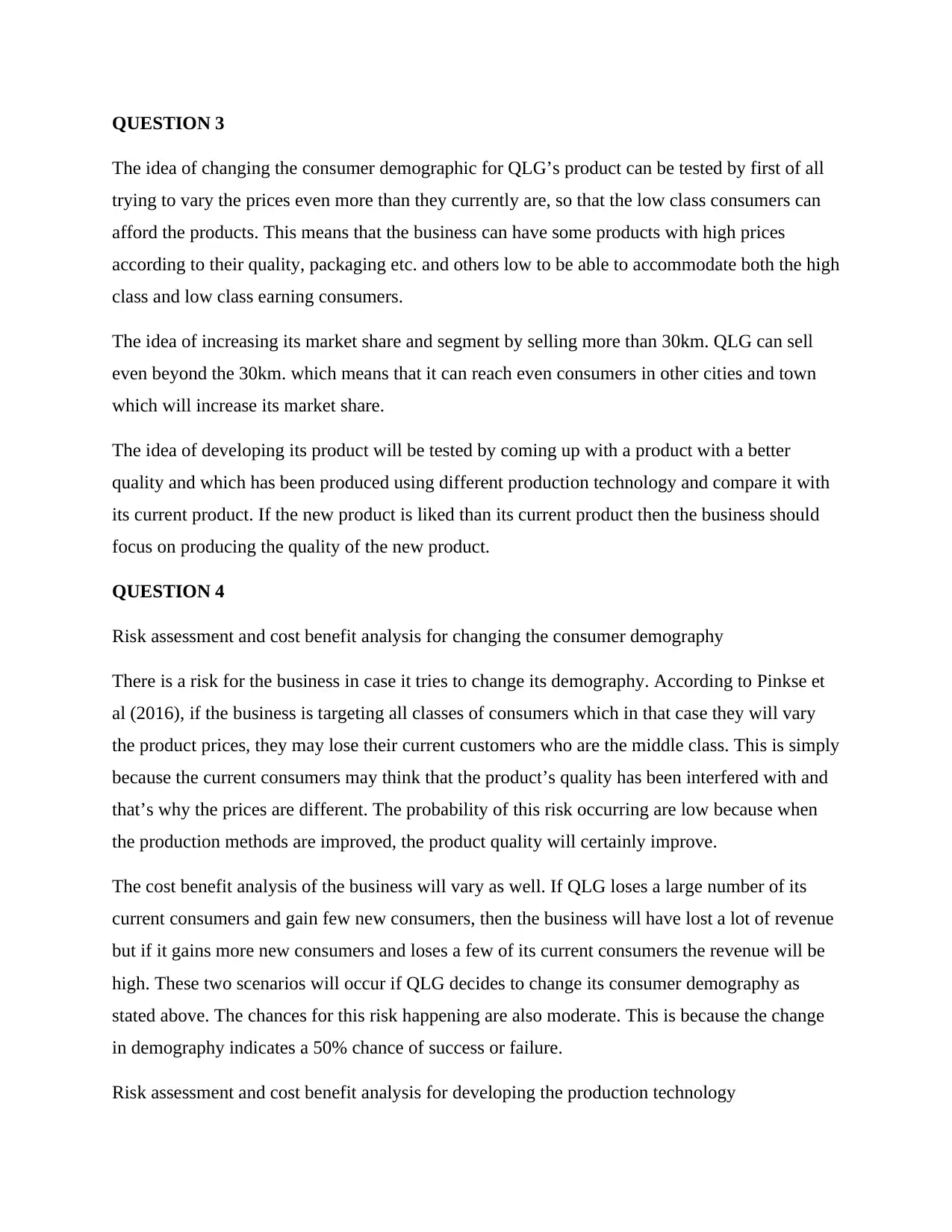
QUESTION 3
The idea of changing the consumer demographic for QLG’s product can be tested by first of all
trying to vary the prices even more than they currently are, so that the low class consumers can
afford the products. This means that the business can have some products with high prices
according to their quality, packaging etc. and others low to be able to accommodate both the high
class and low class earning consumers.
The idea of increasing its market share and segment by selling more than 30km. QLG can sell
even beyond the 30km. which means that it can reach even consumers in other cities and town
which will increase its market share.
The idea of developing its product will be tested by coming up with a product with a better
quality and which has been produced using different production technology and compare it with
its current product. If the new product is liked than its current product then the business should
focus on producing the quality of the new product.
QUESTION 4
Risk assessment and cost benefit analysis for changing the consumer demography
There is a risk for the business in case it tries to change its demography. According to Pinkse et
al (2016), if the business is targeting all classes of consumers which in that case they will vary
the product prices, they may lose their current customers who are the middle class. This is simply
because the current consumers may think that the product’s quality has been interfered with and
that’s why the prices are different. The probability of this risk occurring are low because when
the production methods are improved, the product quality will certainly improve.
The cost benefit analysis of the business will vary as well. If QLG loses a large number of its
current consumers and gain few new consumers, then the business will have lost a lot of revenue
but if it gains more new consumers and loses a few of its current consumers the revenue will be
high. These two scenarios will occur if QLG decides to change its consumer demography as
stated above. The chances for this risk happening are also moderate. This is because the change
in demography indicates a 50% chance of success or failure.
Risk assessment and cost benefit analysis for developing the production technology
The idea of changing the consumer demographic for QLG’s product can be tested by first of all
trying to vary the prices even more than they currently are, so that the low class consumers can
afford the products. This means that the business can have some products with high prices
according to their quality, packaging etc. and others low to be able to accommodate both the high
class and low class earning consumers.
The idea of increasing its market share and segment by selling more than 30km. QLG can sell
even beyond the 30km. which means that it can reach even consumers in other cities and town
which will increase its market share.
The idea of developing its product will be tested by coming up with a product with a better
quality and which has been produced using different production technology and compare it with
its current product. If the new product is liked than its current product then the business should
focus on producing the quality of the new product.
QUESTION 4
Risk assessment and cost benefit analysis for changing the consumer demography
There is a risk for the business in case it tries to change its demography. According to Pinkse et
al (2016), if the business is targeting all classes of consumers which in that case they will vary
the product prices, they may lose their current customers who are the middle class. This is simply
because the current consumers may think that the product’s quality has been interfered with and
that’s why the prices are different. The probability of this risk occurring are low because when
the production methods are improved, the product quality will certainly improve.
The cost benefit analysis of the business will vary as well. If QLG loses a large number of its
current consumers and gain few new consumers, then the business will have lost a lot of revenue
but if it gains more new consumers and loses a few of its current consumers the revenue will be
high. These two scenarios will occur if QLG decides to change its consumer demography as
stated above. The chances for this risk happening are also moderate. This is because the change
in demography indicates a 50% chance of success or failure.
Risk assessment and cost benefit analysis for developing the production technology
Paraphrase This Document
Need a fresh take? Get an instant paraphrase of this document with our AI Paraphraser
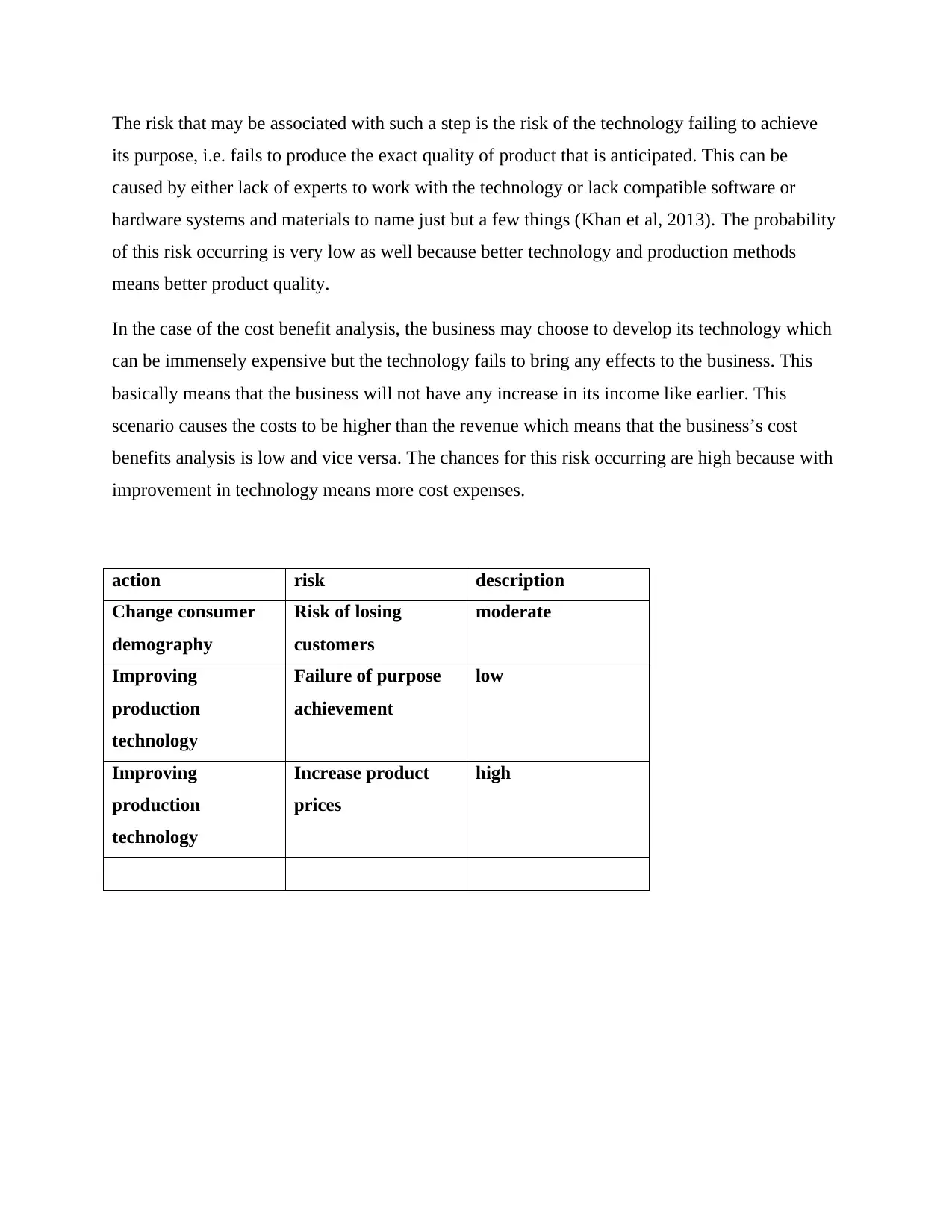
The risk that may be associated with such a step is the risk of the technology failing to achieve
its purpose, i.e. fails to produce the exact quality of product that is anticipated. This can be
caused by either lack of experts to work with the technology or lack compatible software or
hardware systems and materials to name just but a few things (Khan et al, 2013). The probability
of this risk occurring is very low as well because better technology and production methods
means better product quality.
In the case of the cost benefit analysis, the business may choose to develop its technology which
can be immensely expensive but the technology fails to bring any effects to the business. This
basically means that the business will not have any increase in its income like earlier. This
scenario causes the costs to be higher than the revenue which means that the business’s cost
benefits analysis is low and vice versa. The chances for this risk occurring are high because with
improvement in technology means more cost expenses.
action risk description
Change consumer
demography
Risk of losing
customers
moderate
Improving
production
technology
Failure of purpose
achievement
low
Improving
production
technology
Increase product
prices
high
its purpose, i.e. fails to produce the exact quality of product that is anticipated. This can be
caused by either lack of experts to work with the technology or lack compatible software or
hardware systems and materials to name just but a few things (Khan et al, 2013). The probability
of this risk occurring is very low as well because better technology and production methods
means better product quality.
In the case of the cost benefit analysis, the business may choose to develop its technology which
can be immensely expensive but the technology fails to bring any effects to the business. This
basically means that the business will not have any increase in its income like earlier. This
scenario causes the costs to be higher than the revenue which means that the business’s cost
benefits analysis is low and vice versa. The chances for this risk occurring are high because with
improvement in technology means more cost expenses.
action risk description
Change consumer
demography
Risk of losing
customers
moderate
Improving
production
technology
Failure of purpose
achievement
low
Improving
production
technology
Increase product
prices
high
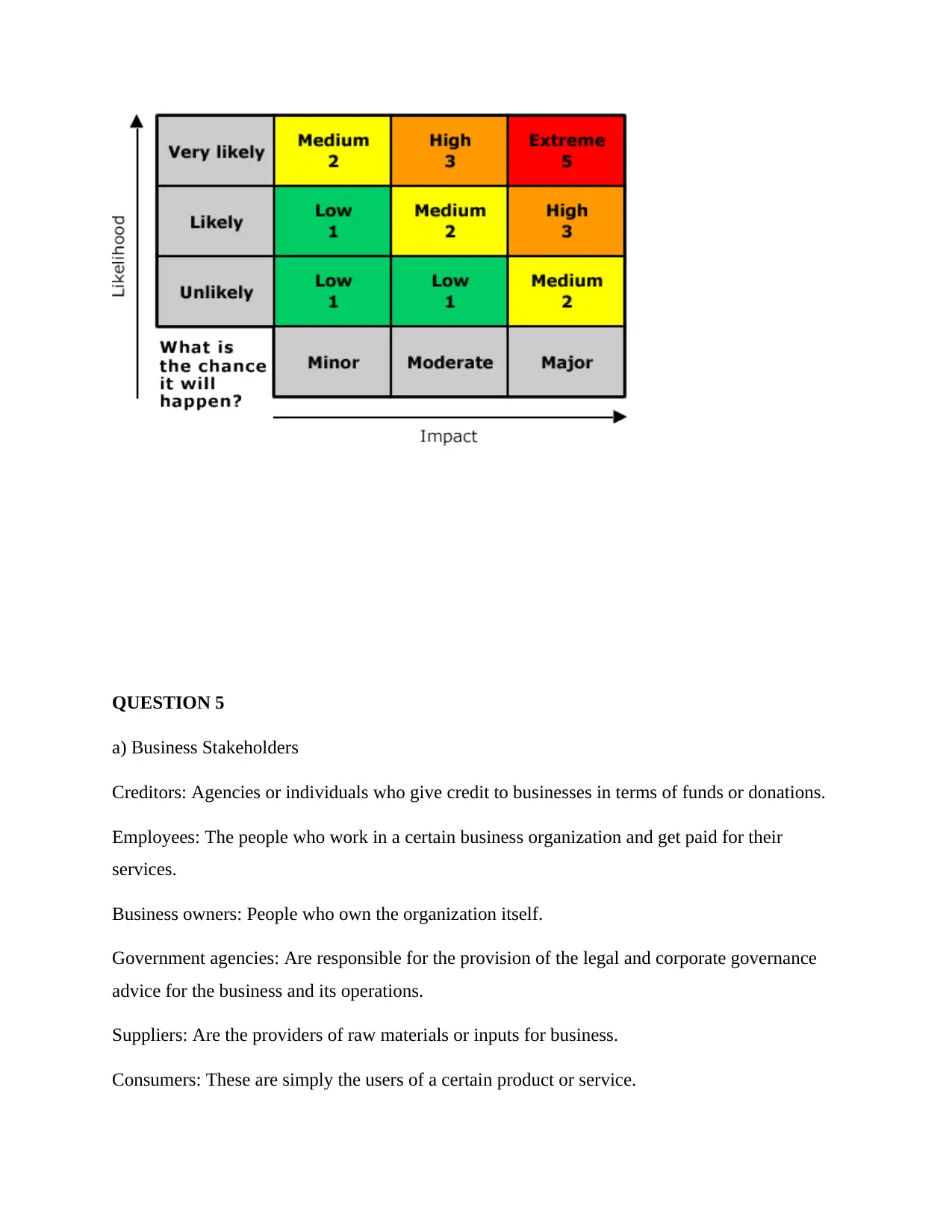
QUESTION 5
a) Business Stakeholders
Creditors: Agencies or individuals who give credit to businesses in terms of funds or donations.
Employees: The people who work in a certain business organization and get paid for their
services.
Business owners: People who own the organization itself.
Government agencies: Are responsible for the provision of the legal and corporate governance
advice for the business and its operations.
Suppliers: Are the providers of raw materials or inputs for business.
Consumers: These are simply the users of a certain product or service.
a) Business Stakeholders
Creditors: Agencies or individuals who give credit to businesses in terms of funds or donations.
Employees: The people who work in a certain business organization and get paid for their
services.
Business owners: People who own the organization itself.
Government agencies: Are responsible for the provision of the legal and corporate governance
advice for the business and its operations.
Suppliers: Are the providers of raw materials or inputs for business.
Consumers: These are simply the users of a certain product or service.
⊘ This is a preview!⊘
Do you want full access?
Subscribe today to unlock all pages.

Trusted by 1+ million students worldwide
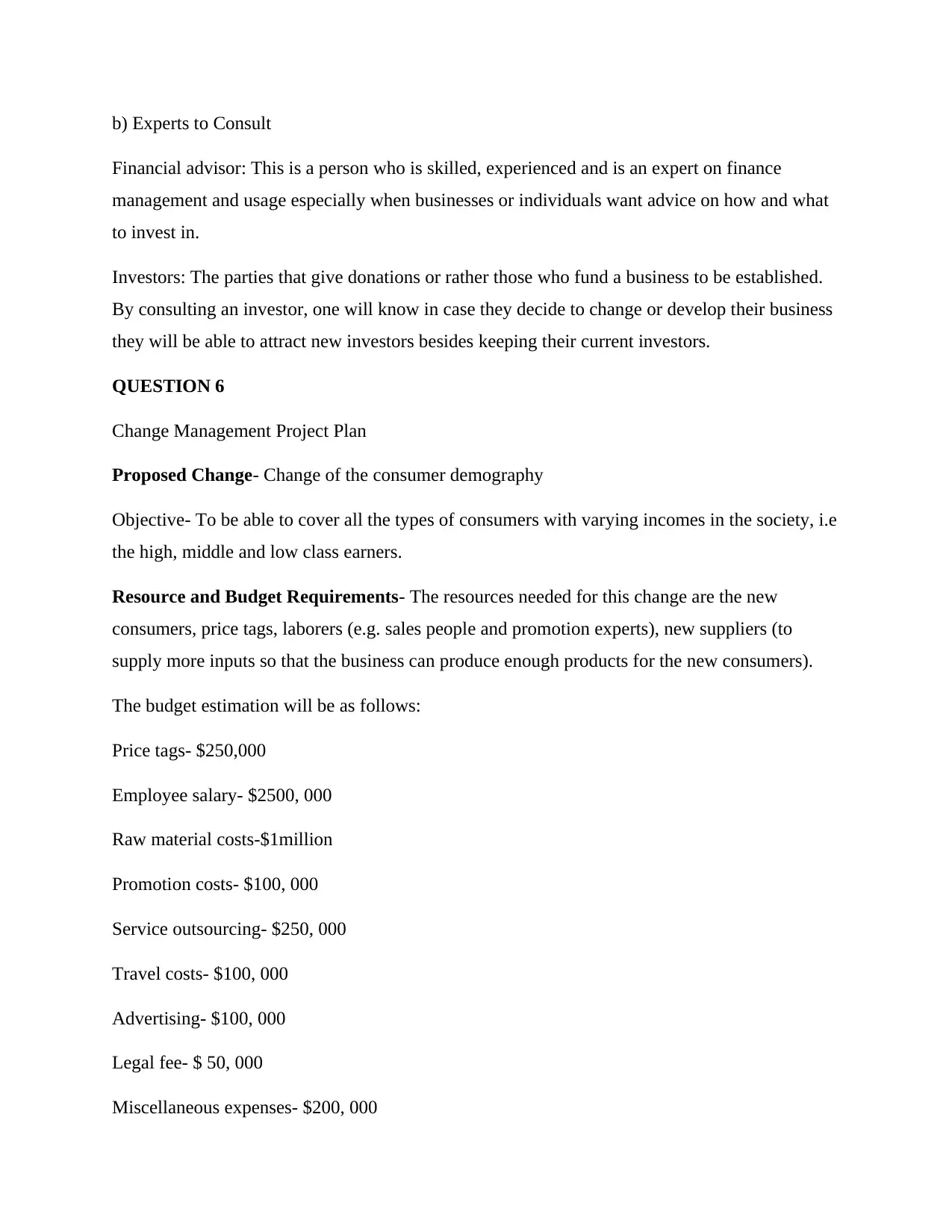
b) Experts to Consult
Financial advisor: This is a person who is skilled, experienced and is an expert on finance
management and usage especially when businesses or individuals want advice on how and what
to invest in.
Investors: The parties that give donations or rather those who fund a business to be established.
By consulting an investor, one will know in case they decide to change or develop their business
they will be able to attract new investors besides keeping their current investors.
QUESTION 6
Change Management Project Plan
Proposed Change- Change of the consumer demography
Objective- To be able to cover all the types of consumers with varying incomes in the society, i.e
the high, middle and low class earners.
Resource and Budget Requirements- The resources needed for this change are the new
consumers, price tags, laborers (e.g. sales people and promotion experts), new suppliers (to
supply more inputs so that the business can produce enough products for the new consumers).
The budget estimation will be as follows:
Price tags- $250,000
Employee salary- $2500, 000
Raw material costs-$1million
Promotion costs- $100, 000
Service outsourcing- $250, 000
Travel costs- $100, 000
Advertising- $100, 000
Legal fee- $ 50, 000
Miscellaneous expenses- $200, 000
Financial advisor: This is a person who is skilled, experienced and is an expert on finance
management and usage especially when businesses or individuals want advice on how and what
to invest in.
Investors: The parties that give donations or rather those who fund a business to be established.
By consulting an investor, one will know in case they decide to change or develop their business
they will be able to attract new investors besides keeping their current investors.
QUESTION 6
Change Management Project Plan
Proposed Change- Change of the consumer demography
Objective- To be able to cover all the types of consumers with varying incomes in the society, i.e
the high, middle and low class earners.
Resource and Budget Requirements- The resources needed for this change are the new
consumers, price tags, laborers (e.g. sales people and promotion experts), new suppliers (to
supply more inputs so that the business can produce enough products for the new consumers).
The budget estimation will be as follows:
Price tags- $250,000
Employee salary- $2500, 000
Raw material costs-$1million
Promotion costs- $100, 000
Service outsourcing- $250, 000
Travel costs- $100, 000
Advertising- $100, 000
Legal fee- $ 50, 000
Miscellaneous expenses- $200, 000
Paraphrase This Document
Need a fresh take? Get an instant paraphrase of this document with our AI Paraphraser
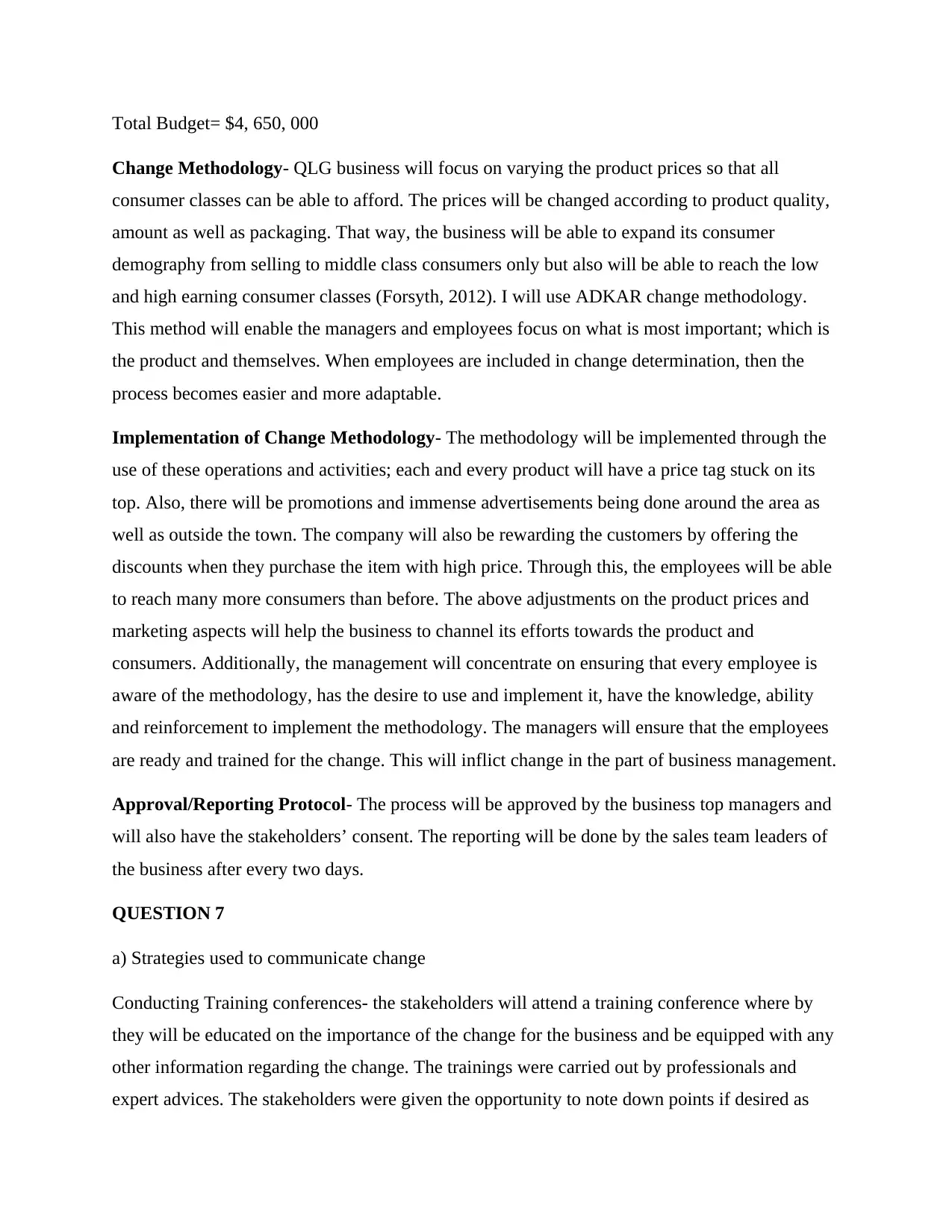
Total Budget= $4, 650, 000
Change Methodology- QLG business will focus on varying the product prices so that all
consumer classes can be able to afford. The prices will be changed according to product quality,
amount as well as packaging. That way, the business will be able to expand its consumer
demography from selling to middle class consumers only but also will be able to reach the low
and high earning consumer classes (Forsyth, 2012). I will use ADKAR change methodology.
This method will enable the managers and employees focus on what is most important; which is
the product and themselves. When employees are included in change determination, then the
process becomes easier and more adaptable.
Implementation of Change Methodology- The methodology will be implemented through the
use of these operations and activities; each and every product will have a price tag stuck on its
top. Also, there will be promotions and immense advertisements being done around the area as
well as outside the town. The company will also be rewarding the customers by offering the
discounts when they purchase the item with high price. Through this, the employees will be able
to reach many more consumers than before. The above adjustments on the product prices and
marketing aspects will help the business to channel its efforts towards the product and
consumers. Additionally, the management will concentrate on ensuring that every employee is
aware of the methodology, has the desire to use and implement it, have the knowledge, ability
and reinforcement to implement the methodology. The managers will ensure that the employees
are ready and trained for the change. This will inflict change in the part of business management.
Approval/Reporting Protocol- The process will be approved by the business top managers and
will also have the stakeholders’ consent. The reporting will be done by the sales team leaders of
the business after every two days.
QUESTION 7
a) Strategies used to communicate change
Conducting Training conferences- the stakeholders will attend a training conference where by
they will be educated on the importance of the change for the business and be equipped with any
other information regarding the change. The trainings were carried out by professionals and
expert advices. The stakeholders were given the opportunity to note down points if desired as
Change Methodology- QLG business will focus on varying the product prices so that all
consumer classes can be able to afford. The prices will be changed according to product quality,
amount as well as packaging. That way, the business will be able to expand its consumer
demography from selling to middle class consumers only but also will be able to reach the low
and high earning consumer classes (Forsyth, 2012). I will use ADKAR change methodology.
This method will enable the managers and employees focus on what is most important; which is
the product and themselves. When employees are included in change determination, then the
process becomes easier and more adaptable.
Implementation of Change Methodology- The methodology will be implemented through the
use of these operations and activities; each and every product will have a price tag stuck on its
top. Also, there will be promotions and immense advertisements being done around the area as
well as outside the town. The company will also be rewarding the customers by offering the
discounts when they purchase the item with high price. Through this, the employees will be able
to reach many more consumers than before. The above adjustments on the product prices and
marketing aspects will help the business to channel its efforts towards the product and
consumers. Additionally, the management will concentrate on ensuring that every employee is
aware of the methodology, has the desire to use and implement it, have the knowledge, ability
and reinforcement to implement the methodology. The managers will ensure that the employees
are ready and trained for the change. This will inflict change in the part of business management.
Approval/Reporting Protocol- The process will be approved by the business top managers and
will also have the stakeholders’ consent. The reporting will be done by the sales team leaders of
the business after every two days.
QUESTION 7
a) Strategies used to communicate change
Conducting Training conferences- the stakeholders will attend a training conference where by
they will be educated on the importance of the change for the business and be equipped with any
other information regarding the change. The trainings were carried out by professionals and
expert advices. The stakeholders were given the opportunity to note down points if desired as
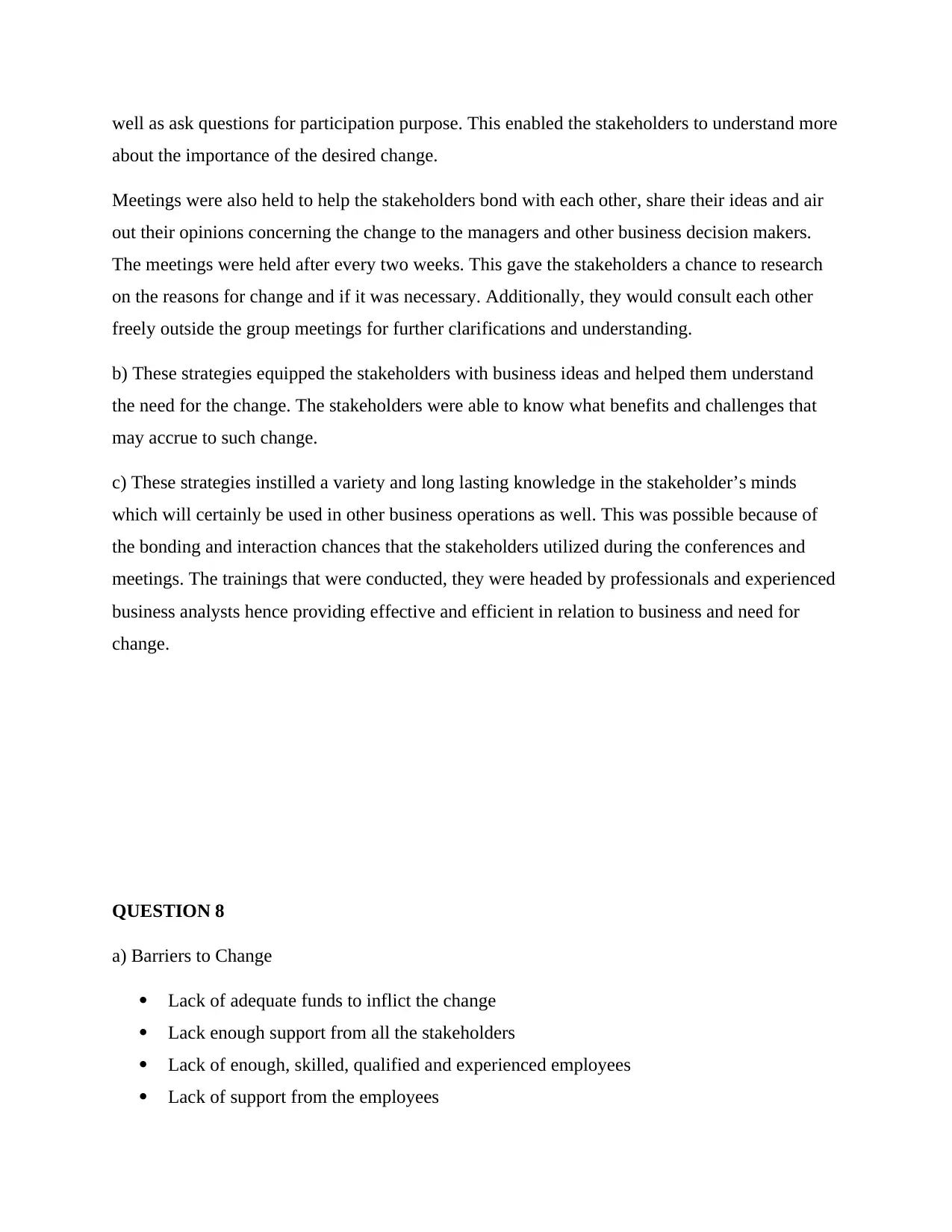
well as ask questions for participation purpose. This enabled the stakeholders to understand more
about the importance of the desired change.
Meetings were also held to help the stakeholders bond with each other, share their ideas and air
out their opinions concerning the change to the managers and other business decision makers.
The meetings were held after every two weeks. This gave the stakeholders a chance to research
on the reasons for change and if it was necessary. Additionally, they would consult each other
freely outside the group meetings for further clarifications and understanding.
b) These strategies equipped the stakeholders with business ideas and helped them understand
the need for the change. The stakeholders were able to know what benefits and challenges that
may accrue to such change.
c) These strategies instilled a variety and long lasting knowledge in the stakeholder’s minds
which will certainly be used in other business operations as well. This was possible because of
the bonding and interaction chances that the stakeholders utilized during the conferences and
meetings. The trainings that were conducted, they were headed by professionals and experienced
business analysts hence providing effective and efficient in relation to business and need for
change.
QUESTION 8
a) Barriers to Change
Lack of adequate funds to inflict the change
Lack enough support from all the stakeholders
Lack of enough, skilled, qualified and experienced employees
Lack of support from the employees
about the importance of the desired change.
Meetings were also held to help the stakeholders bond with each other, share their ideas and air
out their opinions concerning the change to the managers and other business decision makers.
The meetings were held after every two weeks. This gave the stakeholders a chance to research
on the reasons for change and if it was necessary. Additionally, they would consult each other
freely outside the group meetings for further clarifications and understanding.
b) These strategies equipped the stakeholders with business ideas and helped them understand
the need for the change. The stakeholders were able to know what benefits and challenges that
may accrue to such change.
c) These strategies instilled a variety and long lasting knowledge in the stakeholder’s minds
which will certainly be used in other business operations as well. This was possible because of
the bonding and interaction chances that the stakeholders utilized during the conferences and
meetings. The trainings that were conducted, they were headed by professionals and experienced
business analysts hence providing effective and efficient in relation to business and need for
change.
QUESTION 8
a) Barriers to Change
Lack of adequate funds to inflict the change
Lack enough support from all the stakeholders
Lack of enough, skilled, qualified and experienced employees
Lack of support from the employees
⊘ This is a preview!⊘
Do you want full access?
Subscribe today to unlock all pages.

Trusted by 1+ million students worldwide
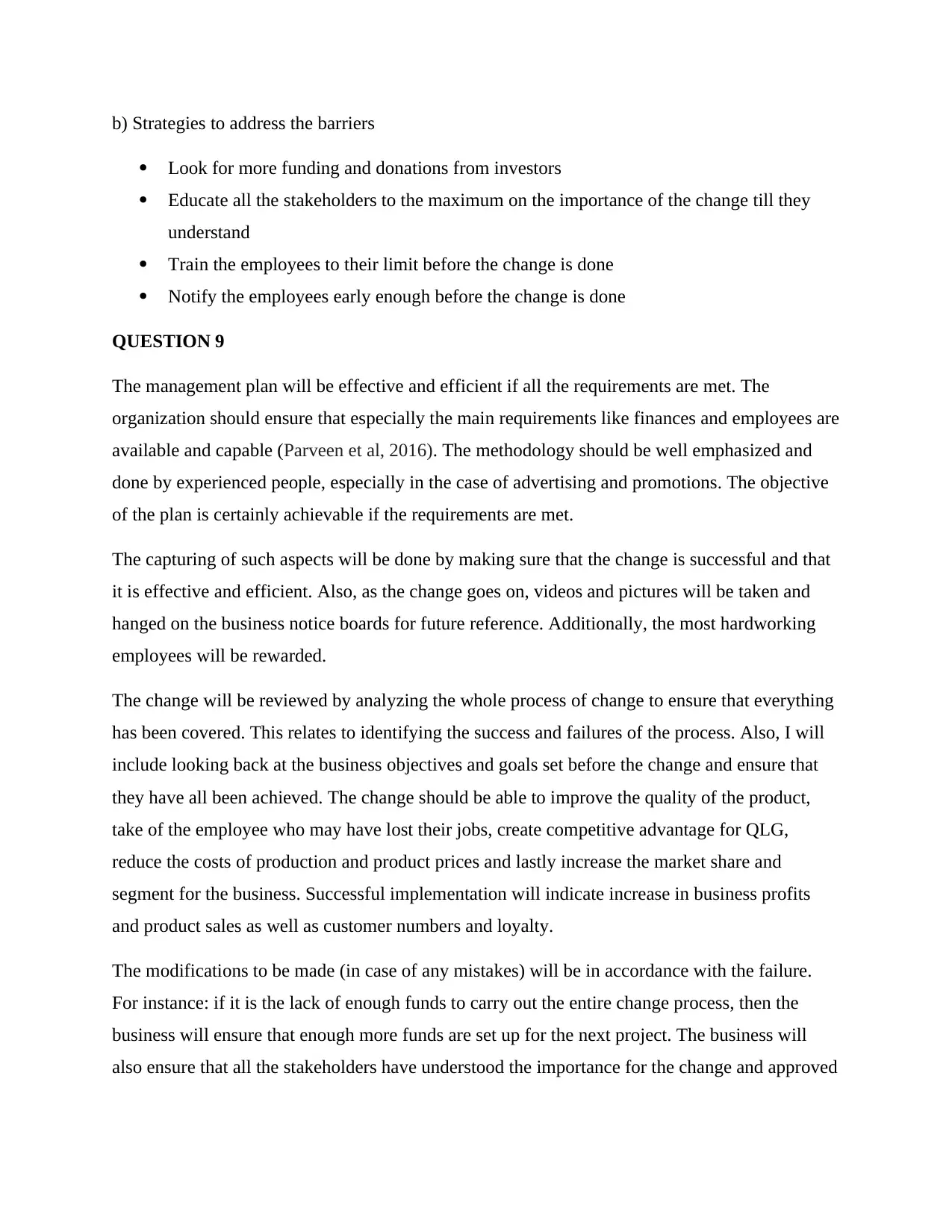
b) Strategies to address the barriers
Look for more funding and donations from investors
Educate all the stakeholders to the maximum on the importance of the change till they
understand
Train the employees to their limit before the change is done
Notify the employees early enough before the change is done
QUESTION 9
The management plan will be effective and efficient if all the requirements are met. The
organization should ensure that especially the main requirements like finances and employees are
available and capable (Parveen et al, 2016). The methodology should be well emphasized and
done by experienced people, especially in the case of advertising and promotions. The objective
of the plan is certainly achievable if the requirements are met.
The capturing of such aspects will be done by making sure that the change is successful and that
it is effective and efficient. Also, as the change goes on, videos and pictures will be taken and
hanged on the business notice boards for future reference. Additionally, the most hardworking
employees will be rewarded.
The change will be reviewed by analyzing the whole process of change to ensure that everything
has been covered. This relates to identifying the success and failures of the process. Also, I will
include looking back at the business objectives and goals set before the change and ensure that
they have all been achieved. The change should be able to improve the quality of the product,
take of the employee who may have lost their jobs, create competitive advantage for QLG,
reduce the costs of production and product prices and lastly increase the market share and
segment for the business. Successful implementation will indicate increase in business profits
and product sales as well as customer numbers and loyalty.
The modifications to be made (in case of any mistakes) will be in accordance with the failure.
For instance: if it is the lack of enough funds to carry out the entire change process, then the
business will ensure that enough more funds are set up for the next project. The business will
also ensure that all the stakeholders have understood the importance for the change and approved
Look for more funding and donations from investors
Educate all the stakeholders to the maximum on the importance of the change till they
understand
Train the employees to their limit before the change is done
Notify the employees early enough before the change is done
QUESTION 9
The management plan will be effective and efficient if all the requirements are met. The
organization should ensure that especially the main requirements like finances and employees are
available and capable (Parveen et al, 2016). The methodology should be well emphasized and
done by experienced people, especially in the case of advertising and promotions. The objective
of the plan is certainly achievable if the requirements are met.
The capturing of such aspects will be done by making sure that the change is successful and that
it is effective and efficient. Also, as the change goes on, videos and pictures will be taken and
hanged on the business notice boards for future reference. Additionally, the most hardworking
employees will be rewarded.
The change will be reviewed by analyzing the whole process of change to ensure that everything
has been covered. This relates to identifying the success and failures of the process. Also, I will
include looking back at the business objectives and goals set before the change and ensure that
they have all been achieved. The change should be able to improve the quality of the product,
take of the employee who may have lost their jobs, create competitive advantage for QLG,
reduce the costs of production and product prices and lastly increase the market share and
segment for the business. Successful implementation will indicate increase in business profits
and product sales as well as customer numbers and loyalty.
The modifications to be made (in case of any mistakes) will be in accordance with the failure.
For instance: if it is the lack of enough funds to carry out the entire change process, then the
business will ensure that enough more funds are set up for the next project. The business will
also ensure that all the stakeholders have understood the importance for the change and approved
Paraphrase This Document
Need a fresh take? Get an instant paraphrase of this document with our AI Paraphraser
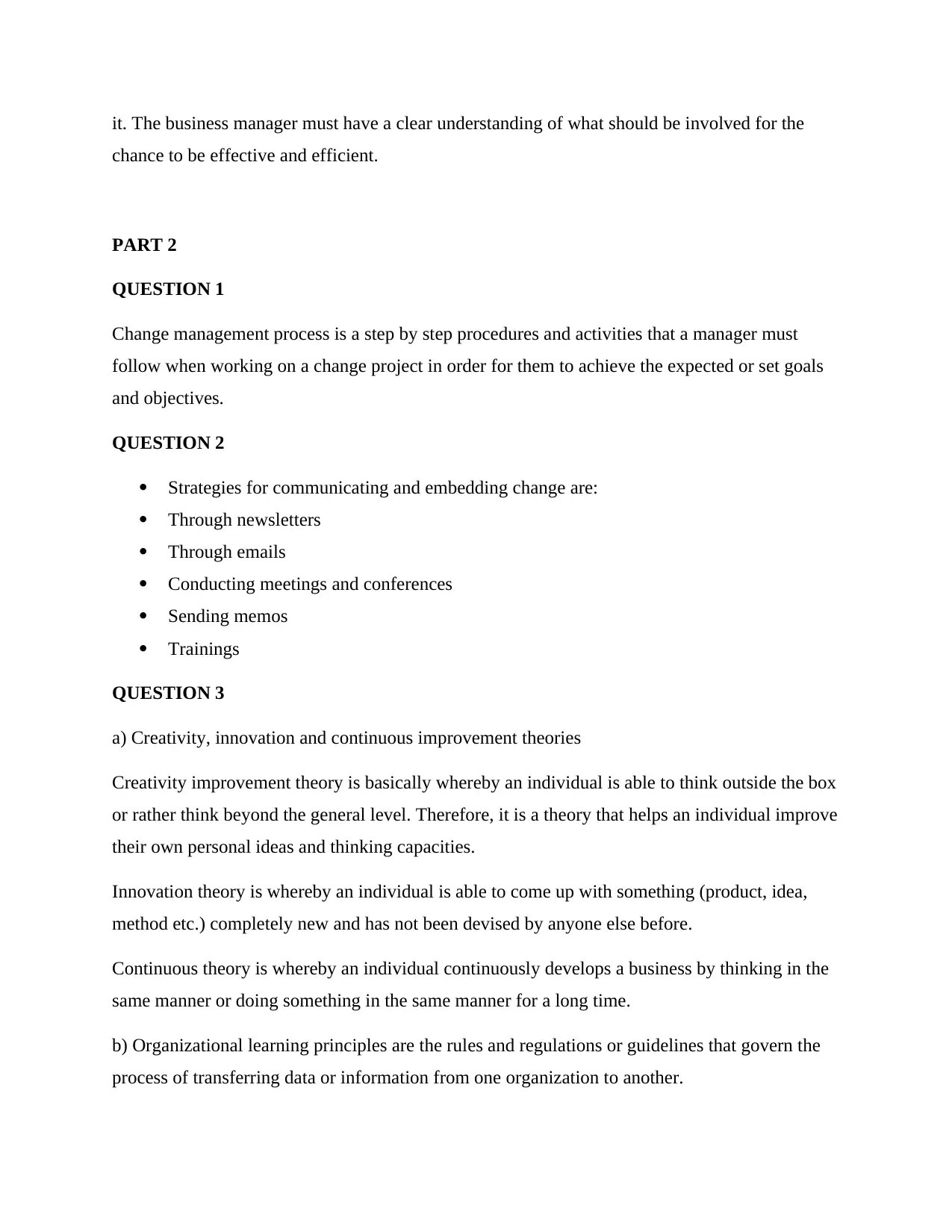
it. The business manager must have a clear understanding of what should be involved for the
chance to be effective and efficient.
PART 2
QUESTION 1
Change management process is a step by step procedures and activities that a manager must
follow when working on a change project in order for them to achieve the expected or set goals
and objectives.
QUESTION 2
Strategies for communicating and embedding change are:
Through newsletters
Through emails
Conducting meetings and conferences
Sending memos
Trainings
QUESTION 3
a) Creativity, innovation and continuous improvement theories
Creativity improvement theory is basically whereby an individual is able to think outside the box
or rather think beyond the general level. Therefore, it is a theory that helps an individual improve
their own personal ideas and thinking capacities.
Innovation theory is whereby an individual is able to come up with something (product, idea,
method etc.) completely new and has not been devised by anyone else before.
Continuous theory is whereby an individual continuously develops a business by thinking in the
same manner or doing something in the same manner for a long time.
b) Organizational learning principles are the rules and regulations or guidelines that govern the
process of transferring data or information from one organization to another.
chance to be effective and efficient.
PART 2
QUESTION 1
Change management process is a step by step procedures and activities that a manager must
follow when working on a change project in order for them to achieve the expected or set goals
and objectives.
QUESTION 2
Strategies for communicating and embedding change are:
Through newsletters
Through emails
Conducting meetings and conferences
Sending memos
Trainings
QUESTION 3
a) Creativity, innovation and continuous improvement theories
Creativity improvement theory is basically whereby an individual is able to think outside the box
or rather think beyond the general level. Therefore, it is a theory that helps an individual improve
their own personal ideas and thinking capacities.
Innovation theory is whereby an individual is able to come up with something (product, idea,
method etc.) completely new and has not been devised by anyone else before.
Continuous theory is whereby an individual continuously develops a business by thinking in the
same manner or doing something in the same manner for a long time.
b) Organizational learning principles are the rules and regulations or guidelines that govern the
process of transferring data or information from one organization to another.
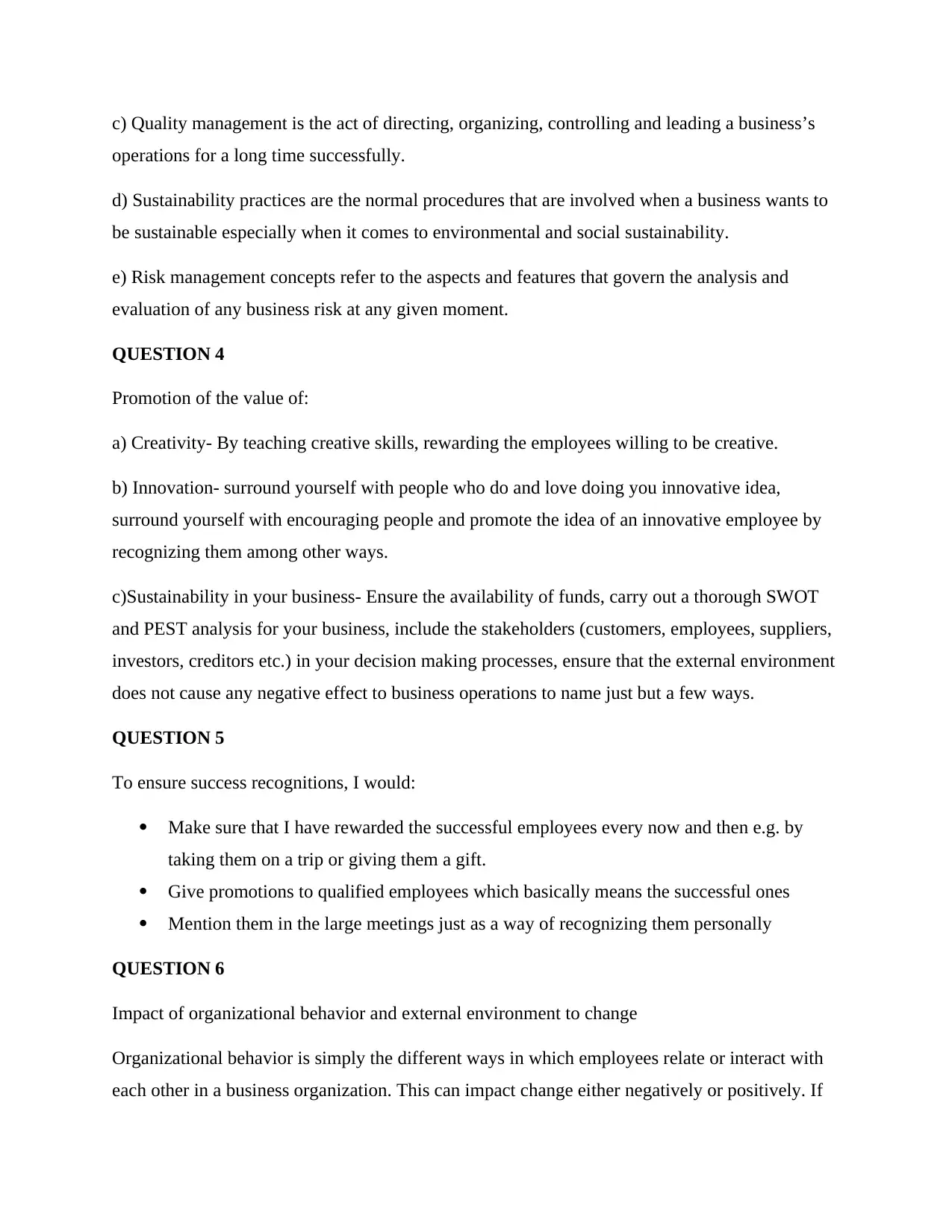
c) Quality management is the act of directing, organizing, controlling and leading a business’s
operations for a long time successfully.
d) Sustainability practices are the normal procedures that are involved when a business wants to
be sustainable especially when it comes to environmental and social sustainability.
e) Risk management concepts refer to the aspects and features that govern the analysis and
evaluation of any business risk at any given moment.
QUESTION 4
Promotion of the value of:
a) Creativity- By teaching creative skills, rewarding the employees willing to be creative.
b) Innovation- surround yourself with people who do and love doing you innovative idea,
surround yourself with encouraging people and promote the idea of an innovative employee by
recognizing them among other ways.
c)Sustainability in your business- Ensure the availability of funds, carry out a thorough SWOT
and PEST analysis for your business, include the stakeholders (customers, employees, suppliers,
investors, creditors etc.) in your decision making processes, ensure that the external environment
does not cause any negative effect to business operations to name just but a few ways.
QUESTION 5
To ensure success recognitions, I would:
Make sure that I have rewarded the successful employees every now and then e.g. by
taking them on a trip or giving them a gift.
Give promotions to qualified employees which basically means the successful ones
Mention them in the large meetings just as a way of recognizing them personally
QUESTION 6
Impact of organizational behavior and external environment to change
Organizational behavior is simply the different ways in which employees relate or interact with
each other in a business organization. This can impact change either negatively or positively. If
operations for a long time successfully.
d) Sustainability practices are the normal procedures that are involved when a business wants to
be sustainable especially when it comes to environmental and social sustainability.
e) Risk management concepts refer to the aspects and features that govern the analysis and
evaluation of any business risk at any given moment.
QUESTION 4
Promotion of the value of:
a) Creativity- By teaching creative skills, rewarding the employees willing to be creative.
b) Innovation- surround yourself with people who do and love doing you innovative idea,
surround yourself with encouraging people and promote the idea of an innovative employee by
recognizing them among other ways.
c)Sustainability in your business- Ensure the availability of funds, carry out a thorough SWOT
and PEST analysis for your business, include the stakeholders (customers, employees, suppliers,
investors, creditors etc.) in your decision making processes, ensure that the external environment
does not cause any negative effect to business operations to name just but a few ways.
QUESTION 5
To ensure success recognitions, I would:
Make sure that I have rewarded the successful employees every now and then e.g. by
taking them on a trip or giving them a gift.
Give promotions to qualified employees which basically means the successful ones
Mention them in the large meetings just as a way of recognizing them personally
QUESTION 6
Impact of organizational behavior and external environment to change
Organizational behavior is simply the different ways in which employees relate or interact with
each other in a business organization. This can impact change either negatively or positively. If
⊘ This is a preview!⊘
Do you want full access?
Subscribe today to unlock all pages.

Trusted by 1+ million students worldwide
1 out of 14
Related Documents
Your All-in-One AI-Powered Toolkit for Academic Success.
+13062052269
info@desklib.com
Available 24*7 on WhatsApp / Email
![[object Object]](/_next/static/media/star-bottom.7253800d.svg)
Unlock your academic potential
Copyright © 2020–2025 A2Z Services. All Rights Reserved. Developed and managed by ZUCOL.





